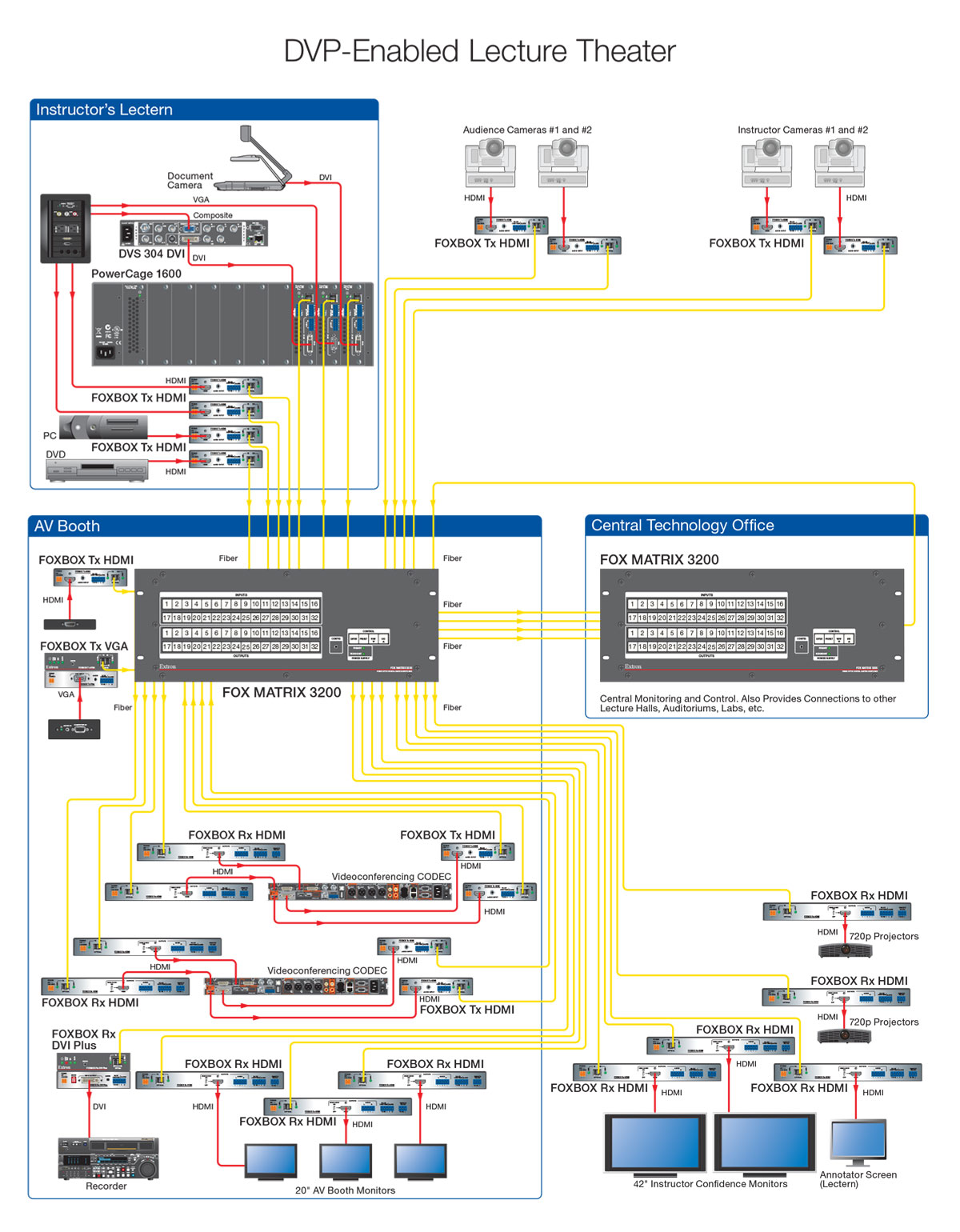
Training the Future Doctors of British Columbia
Innovative AV and Fiber Optics Ensure Equal Learning Experience for Future Doctors of British ColumbiaEarly in 2002, British Columbia was faced with a critical shortage of doctors to serve its approximately 4.6 million citizens. Additionally, the northern, southern, and island regions had a difficult time enticing new doctors to set up practices beyond Vancouver’s metropolitan area. Two primary factors contributed to this situation. First, the Faculty of Medicine – FoM at the University of British Columbia – UBC in Vancouver can accept a maximum of 128 new students each year. Second, continuing medical education opportunities tend to occur in the lower mainland, which attracts new doctors to that region where they remain for the duration of the four-year undergraduate program and primarily remain in the area for the two to seven years required to complete their residency and specialization studies. They develop professional and social attachments over this extended period and end up settling in and around Vancouver rather than return to their native regions or set up practices in remote locations.
To address the need for more physicians in all regions of the province, the Ministry of Health issued a mandate to UBC. The annual number of new doctors graduating from the program had to double, and new medical practices were to be established in rural and underserved areas.
Dr. Joanna Bates, FoM Senior Associate Dean at UBC, accepted this daunting assignment. In cooperation with government officials, the University of Northern British Columbia – UNBC, the University of Victoria – UVic, and the province’s six health authority organizations, Dr. Bates and her project team developed a plan to implement the Ministry’s mandate using technology.
Utilizing Technology to Enable Learning
The team’s premise was to use technology to train medical students in their home regions while utilizing the expertise of UBC instructors. The plan avoided the expense of developing full medical school facilities in multiple locations and the difficulty of finding enough qualified instructors living in the remote areas. The Ministry of Health agreed to fund the project for a three-year trial period.
Various AV system design firms told the project team that the technology of the time was incapable of meeting their needs; the leadership at McSquared System Design Group Inc. of Vancouver saw it as a challenge. Working closely with the project team and BCNet – British Columbia’s shared IT services consortium for higher education, McSquared conceptualized an enterprise system that would become the core of the province’s new Distributed Medical Program – DMP.
The prototype DMP-AV system included two lecture theaters at each of the three university campuses. It enabled an instructor at UBC to teach students at UNBC and UVic as well as the local students. UNBC in Prince George is approximately 500 miles (805 kilometers) north of Vancouver, and UVic is 57 miles (92 kilometers) across the Georgia Straight on Vancouver Island. Post graduates at the Gordon & Lesley Diamond Health Care Center located on the grounds of Vancouver General Hospital were also able to participate through a room linked to the prototype system.
“My colleagues and I had done a lot of videoconferencing beforehand but nothing of this nature or scope,” says Marcel Schoenenberger, Principal Consultant at McSquared System Design Group Inc. “We really had to work within and develop very stringent requirements so that the students at remote participating sites would receive an education that’s equal to the students participating locally.”
Launched in 2004, the DMP-AV system consists of a myriad of interlinking technologies that enable simultaneous and interactive training at and between facilities.
At the end of the experimental phase, the prototype had proven to be even more effective than anticipated. Capitalizing on this success, the Ministry drafted the Medical Provincial Academic & Affiliated Campus Technology – MPAACT initiative in 2005. The initiative lists general goals for expansion of the program, including enhanced system performance and a future-proof design.
The plan mandates additional training sites for both the undergraduate and graduate programs. New spaces range from large scale FoM facilities at the universities and teaching hospitals to one or more technology-driven training rooms at regional hospitals and remote medical practices. Under the tenure of Dr. Kristin Sivertz, FoM Senior Associate Dean at UBC, these specialized training sites began to come online as part of the distance education AV system.
Designing Innovation into a Technology
To understand the scope of the distance education AV system, it is necessary to go back to the beginning. In 2002, McSquared determined that the best method to ensure an equal learning experience was to support simultaneous voice-activated videoconferencing. It was imperative to create a large scale system that enables all students to view course materials and communicate directly with the instructor and participants at remote sites.
After approaching a number of conferencing equipment manufacturers, McSquared elected to work with Tandberg, Inc. Together, the two companies developed the technology that became the Dual Visual Presence – DVP dual codec videoconferencing system. The DVP component of the distance education AV system enables participants in multiple locations to interact with each other in real time. A selection of industry-leading AV and control products completed the system.
Facility planning came next. As most AV professionals have experienced firsthand, the general contractor is finishing room layout before the client considers AV needs. From the beginning, this project was different. McSquared worked directly with the architect and general contractors on building and space designs. Blueprints and room plans were modified to address any and all factors that could interfere with a student’s learning experience. To achieve required system performance, the consultant coordinated project assignments, worked with the various teams, and oversaw all related or involved disciplines, ranging from HVAC, electrical, and lighting systems to room layout and color pallets. Release of the MPAACT initiative compounded these responsibilities.
Creating a Future-Proof Design with Fiber Optic Technology
During Phase 1 of the upgrade to a digital system, coax and CAT 5 cables were run at each facility. Because the distance education AV system shares conduit, closets, and cable trays with active systems, those overseeing network activities and service were insistent that future AV upgrades have little to no impact on existing operations. Stakeholders also voiced concerns about possible service disruptions and costs associated with an infrastructure upgrade.
The recommendation of a fiber optic AV routing system at each facility was in direct response to these concerns. As a future-proof solution, fiber allows the continual renewal of active hardware while enabling each facility’s cable infrastructure to stay in place. It also supports MPAACT requirements for high performance switching of pixel-perfect images and immunity to electrical interference.
To validate the long term value of a fiber optic design to the stakeholders, the consultant prepared a cost risk assessment. Factors used to calculate the risk assessment include capital procurement cost, operational cost over system lifespan, and the potential savings of leaving the infrastructure in place at the time of capital renewal. This was with the understanding that any CAT 5 cabling installed in 2009/2010 would need to be replaced during the next and subsequent renewal cycles. The supposition was that a cable manufacturer would not guarantee performance unless the infrastructure was upgraded to the standard of the time. In other words, if eight years from the renewal date the standard for twisted pair systems is CAT 7, then the CAT 5 infrastructure would need to be replaced at the same time as the active hardware.
The assessment includes the widest range of details conceivable. One risk analysis calculation, for example, compares the cost of running cabling from a lectern to a rack located at the back of a lecture theater. In addition to typical renewal expenses, the formula takes into account the cost per linear foot of cable, termination, labor, and potential operational or service issues. When comparing the calculation for running ten CAT 5 cables versus one 12-strand fiber optic cable, the risk assessment confirmed that the expense, time requirement, and difficulties associated with replacing the infrastructure at the time of capital renewal far outweighed the cost of a fiber optic system that remains in place. This became readily apparent to all stakeholders, particularly to those in charge of hospital facilities where shutting down critical medical systems or powering down a floor is not an option.
Signal Integrity and System Reliability with Digital Technology
In 2005, McSquared offered an upgraded design utilizing digital technology to meet MPAACT requirements. The design lists select brands and products by function to ensure device interoperability, optimal signal integrity, and high reliability. Specified brands include Extron for AV switching and distribution, Tandberg – which is now Cisco - for the videoconferencing network, Biamp for audio, and Crestron for control. The recommended solutions were tested individually and in combination with other system components to validate the design.
The digital AV system is designed to deliver high resolution video images to lecture theaters, laboratories, and seminar and Problem Based Learning – PBL rooms. It enables close examination of shared microscopic samples and coloraccurate views in training sessions, including multipurpose or dry lab and gross anatomy or wet lab exercises. Digital sound systems and enhanced control operations round out the design. By the end of that same year, the upgrade to a digital system was underway.
Optimum AV Drives the Learning Experience
Factors to consider when designing any distance education AV system include original image size and distances for readability, vertical viewing angles, color accuracy, and zoomed viewing capabilities. Because pixel size relative to viewing distance and angle determines perceived image quality, these elements influence how each room is shaped, where individuals may sit or stand, and mounting locations of cameras and displays.
An additional requirement of a medical application is the necessity to achieve and maintain precise display calibration to support Digital Imaging and Communications in Medicine, or DICOM. This technology ensures interoperability between high definition medical imaging equipment and video system components without loss of image quality or color tone. For example, new imaging devices with DICOM support contributed to the need for digital displays in the large seminar rooms. Analog projectors were replaced with three 65" flat panel displays that are mounted side by side to achieve the proper sizeto- distance ratio. The system parameters define the proper calibration of the display device’s Content Channel settings to suit the requirements for medical imagery.
Content is arranged so that the center screen displays the instructor while a side screen shows course materials and the other provides windowed views of the other active locations. A later renewal cycle included installation of 103-inch displays in the larger spaces, further augmenting readability from back rows and more sharply angled seats.
High Speed Switching and Distribution
Phase 2 of the digital system upgrade required that the system provide high speed routing of the highest resolution signals in a future-proof design. McSquared and Medicine IT - MedIT at UBC agreed that the system had to be based on fiber optic technology. They began evaluating different fiber optic switching and distribution solutions in 2007.
After testing a wide selection of fiber optic solutions, the project team selected the Extron FOX Matrix system. According to project team members the FOX Matrix provides the performance, functional requirements, and reliability they needed. “The track record for product manufacturing, services provided, and turnaround time is very important factors; so was the ability for us to have input into the engineering process,” Schoenenberger says. “I think that’s another area where Extron stands out. They listen first and then they go to work.”
To offer proof of design and product specification, McSquared arranged for the representatives from FoM, university administration and IT departments, and other stakeholders to witness a comprehensive series of live testing demonstrations at Extron’s headquarters in Anaheim, CA. Testing provided validation of system interoperability between source and destination components and, from a technical perspective, confirmed that the matrix switcher’s performance, image quality, and reliability easily achieved curriculum sharing requirements.
The decision to implement the new digital design at each facility was unanimous. In 2008, existing sites as well as facilities under construction were scheduled to migrate to a fiber optic AV routing system based on Extron’s FOX Matrix and extension products.
Speech Reinforcement
An equally important concern in a distributed training model is speech intelligibility. Fundamentally, videoconferencing is a methodology intended for small groups and works best when parameters such as acoustics, lighting, and room size are carefully specified. In larger spaces, poor room layout can lead to sound distortion and dead zones. To ensure clear sound in DVP-enabled spaces, facilities are designed with a centralized digital signal processing system by Biamp. Microphones are mixed for in-room delivery using an auto mixer to manage feedback and allow simultaneous audio signal processing with automatic gain control and digital echo-canceling. The speech reinforcement system also enables management of audio signal equalization, signal delay, compression, limiting, and level adjustment requirements.
The digital signal processor is integrated into the distance education AV system to share audio with multiple sites. When a facility's AV playback system is selected as the source, loudspeakers associated with a room’s main displays combine with the speech reinforcement system to provide audio to the other active locations.
Bridging the Gaps Between Structures
Part of the upgrade involves signal transmission between different buildings or facilities on the same campus. The latest design incorporates additional video, audio, and streaming functionality tie-ins, such as the tie-in for the jumpalone video format system that transports native video signals. Each building’s VLAN provides the link for high resolution videoconferencing, simplifying installation and controlling costs by reducing the overall number of home runs between campus locations.
The design works particularly well at UBC where the Life Sciences Centre is one building within a cluster of buildings that house distributed education facilities. Built to support the distributed medical training program, its networks have significant overhead to allow installation of either a B Level or C Level VLAN, which is dependent on need. Other facilities required extensive retrofitting to support this level of communication.
The Equal Learning Experience
According to FoM instructors, face-toface exchanges and high quality images are essential to closing the geographic gap and holding successful lectures and lab exercises. The distance education AV system enables selective windowing of the instructor, audiences, individual participants, and video sources on each monitor and display - see the signal flow diagram on page 30. A screen can and often does include images from a computer, medical imaging equipment, and a local document camera or DVD player, as well as content sourced from remote sites. For example, a typical histology lesson requires students to attend a lecture and then pair up to apply the theory in a lab exercise. The instructor may be presenting from a remote facility while groups work on their digital slide exhibits in local labs. During the lecture, each screen displays images of the instructor, participants, and course materials, such as slides from the instructor’s laptop and images from medical equipment or a facility server. When the lab exercise begins, screens are switched to display pertinent lesson data.
In a typical dry lab, each pair of seats includes two monitors and a gooseneck microphone. One monitor displays the lesson data and the other is used as the main channel. To ask for recognition, a student simply pushes a button on the microphone base. Once the instructor activates the student’s mic, the appropriate PTZ camera automatically focuses on that station. If the instructor is occupied with another group, local teaching assistants can also provide clarification of an assignment.
Wet labs are set up differently. Displays are ceiling mounted and angled for ease of viewing and to protect the panels from accidental damage. Lab technicians are on hand to address minor issues and alert the instructor of questions. If a group experiences a unique situation, the anatomical specimen is positioned under a lab camera so that the instructor may zoom in for all participants to see and discuss.
Whether the presentation is local or being taught from a remote site is unimportant. The distance education AV system allows control of views and communication, regardless of the number and location of active sites.
Multiple Points of Control Simplify Operation
Instruction can be shared from any facility in the system. The distance education AV system reaches approximately 130 rooms in the wider system to share instruction across four universities and over 25 hospitals. Rooms are reserved using Resource Scheduler, a space-booking program made by PeopleCube of Assure Software.
Each room includes ceiling loudspeakers and PTZ cameras as standard equipment. The size and intended usage of a space determines the selection and quantity of other in-room devices, with similar types of spaces having like AV products and control capabilities.
The Videoconferencing Support Desk located in the Diamond Health Care Centre is the primary point of system monitoring and master control. This support desk in Vancouver is responsible for establishing and maintaining active links among any selection of facilities and can remotely operate individual spaces. Default sound levels and camera angles are set from either this support desk or a facility’s Central Technology Office. “The support desk can fix a vast majority of user problems remotely, without the intervention of a site technician. It has optimized our resourcing without impacting our just-in-time service levels,” says Anthony Knezevic, Senior Manager of Collaboration Technologies, MedIT Faculty of Medicine at UBC.
Facility-based Control Rooms
Each university and clinical campus has a Central Technology Office to monitor and help manage in-session AV signal switching and distribution - see the signal flow diagram on page 33. The majority of large seminar rooms have direct connection to the facility’s control room over multimode fiber optic cable for system monitoring by support personnel, as well as AV control. Control room staffing is determined by location size and session needs.
The standard control room layout includes two or more AV equipment racks to support one or more DVP-enabled spaces, depending on room adjacencies. The benefit of positioning the AV racks in the control room is twofold. Removing the equipment from the instructional space helps to minimize noise, which could be disruptive to both local and distributed instruction. It also allows better temperature regulation of expensive rack-mounted equipment.
Facility renovations did not always allow the Central Technology Office to be positioned adjacent to DVP-enabled spaces. In this situation, the control room is located elsewhere in the building and a separate rack room allows AV devices to remain close by. Some facilities without space for a control room are supported remotely by the closest active facility with control capabilities.
When it is necessary to install the Central Technology Office in a different campus building, usually the distance education AV system enables communication between structures. However, the fiber optic infrastructure extends between buildings in certain unique installations such as the application at UVic. The university includes a backup operations system that seizes control of all campus networks and systems during an emergency. In addition to multimode cabling within the medical facility, singlemode cabling provides connectivity between the facility’s Central Technology Office in the IMP building and the UVic emergency operations center. Other university locations are already at work on this type of solution as well.

Front of Room Control
To operate local and remote AV sources and displays from the front of the room, a touchscreen is mounted to the instructor’s lectern. This control interface enables precise control of image selection and window arrangement, on-screen annotation, activation of participant microphones, and operation of other equipment, such as a document camera or Blu-ray Disc player.
To create familiarity for periodic and traveling instructors, room control needs to be alike from space to space. For example, the interface in a teaching hospital’s lecture theater supports operation of lectern-based AV equipment and control of the environment, including lighting levels, camera angles, and speaker volume. The interface also enables control of devices at active remote sites, such as pulling data from a university’s file server or activating a remote participant’s mic. Confidence monitors are mounted on or within sight of the lectern to provide a view of the displayed images. Once accustomed to system capabilities and device operation, the instructor is comfortable teaching from a lecture theater at another facility.
The AV operations group and educational technology group place emphasis on instructor training and orientation, as well as ongoing support, to promote the necessary changes in instruction needed in a distributed environment. This has been a key success factor in the positive experiences students have expressed through annual surveys.
The practical, forward-thinking features of the system allow each space to be utilized to its fullest. All instruction is in real time, regardless of the ever increasing number of distance education AV system facilities.
Environmental Adaptations to Existing Spaces
Upgrading an AV system to a digital design requires environmental changes as well as a new infrastructure and hardware. McSquared set the original building specifications particularly high for the FoM facility at UBC, but most sites utilize existing rooms for training purposes.
Space redesigns cover a wide range of specified environmental parameters, from architectural elements that could inhibit line-of-sight between instructor and student to wall color and exact spacing between seats. For example, one environmental parameter addresses the number and degree of reflective surfaces in a given space. High definition digital cameras with high resolution signal output are more susceptible to low ambient light levels than the original analog composite video cameras used to capture lectures and labs. Higher ambient light levels require a stronger contrast ratio on the screens, which requires an upgraded lighting system to support the HD cameras without washing out displayed images. Reflective surfaces affect lighting, having a direct impact on screen visibility.
Upgrading AV at a Medical Facility
Construction in a medical environment is different from construction in any other type of building. McSquared and system integrators work closely with program stakeholders to minimize disruptions at operational sites, while ensuring that students receive an equal learning experience throughout building construction, retrofitting of existing facilities, and distance education AV system upgrade phases.
While a new building such as the one completed at Kelowna General Hospital in 2010 is designed with sufficient cooling and power to support DVP-enabled spaces, system upgrades within hospital settings require careful planning and execution to prevent disruption of service. Dust control is also a big component, with specific spaces requiring a hermetic seal because of room adjacencies. Some retrofitted spaces are very close to emergency rooms or surgical wings so an unscheduled cut of power or water is not an option.
This was the situation at St. Paul’s Hospital, one of the oldest acute care facilities in downtown Vancouver. In 2011, a full size clinical academic campus was installed in the hospital’s basement. The facility includes a retrofitted 170-seat lecture theater and new construction of a 70-seat lecture theater, two seminar rooms, and a Central Technology Office. These spaces are directly below the surgical suites. Throughout the installation, every effort was made to meet the construction schedule without inconveniencing the surgeons or jeopardizing patient care.
“The toughest undertaking with existing facilities and operational hospital environments is securing the appropriate space and then working with an architect or design team to make that space fit the need,” Schoenenberger says. “Once that part is done, then you still have to implement the technology without taking down the whole floor.”
Construction Zone Issues & Concerns
A complication arose at a number of facilities when it was time to replace existing runs with fiber optic cabling. During Phase 1, a variety of lubricants had been applied to the cabling to ease pulling through conduit. Unfortunately, certain gels had degraded over time into an adhesive. Integrators had to use force to remove the previous infrastructure, occasionally damaging conduit, walls, and horizontal surfaces. Removing the old cabling was costly and caused periodic schedule overruns, but this best practice was necessary to meet Canada’s building codes and standards.
During the initial upgrade to digital, another factor that caused installation delays at multiple locations was temperature control. From a building perspective, rack-mounted digital devices produce more heat than analog products. On average, the power consumption and generated heat load of a digital switcher or signal processor is higher by as much as 30%. Although fiber optics use light to transmit signals, the components generate as much heat as other digital devices and more heat than analog products.
If a facility’s air conditioning system does not have the necessary overhead, the cooling capacity in rack rooms and control rooms may prove to be insufficient. New cooling modules or changes to the HVAC infrastructure allow for improved temperature regulation. Although this increases the cost of an individual project, the process extends product life for long term savings and, more importantly, ensures system reliability for up to 10 years.
According to Schoenenberger of McSquared, power is typically less of an issue. Designed to support a wide range of medical devices with unknown power needs, facilities have sufficient overhead to accommodate the power requirements of a digital system. However, power issues at specific locations can negatively impact system reliability. For example, the power grid at UNBC is very susceptible to brownouts. The university’s system includes extensive surge protection, online UPS modules, UPS battery extenders, etc. to provide backup power for a defined period of time.
Achievement of MPAACT Mandates
As each DVP-enabled space is brought online, all systems and connections are tested at that site and between linked facilities. Commissioning of individual systems and the enterprise application combined with continuous system monitoring from the support desk contribute to the achievement of 99% system uptime.
The upgrade to a future-proof fiber optic design offers other advantages, such as a much smaller electrical infrastructure that is isolated. Fiber provides emissionfree transmission of AV and control signals and avoids causing electrical noise to delicate medical instrumentation, which is also a requirement of the MPAACT initiative.
Electromagnetic interference – EMI is a concern in any medical training facility, and DVP-enabled spaces within regional hospitals and remote practices are especially susceptible to ground noise and electrical emissions. DMP facilities typically share space with research centers, blood and gross anatomy labs, surgical suites, simulation rooms, and acute and ambulatory care units, which have equipment that emits various levels of electrical interference. FoM facilities are also exposed to other sources of EMI, including intranet and control networks for data streams, door locks, environmental settings, and a variety of other systems. In a setting that is subject to a constant bombardment of EMI noise, fiber optic technology provides the requisite transmission isolation and performance without impacting other systems or networking operations.
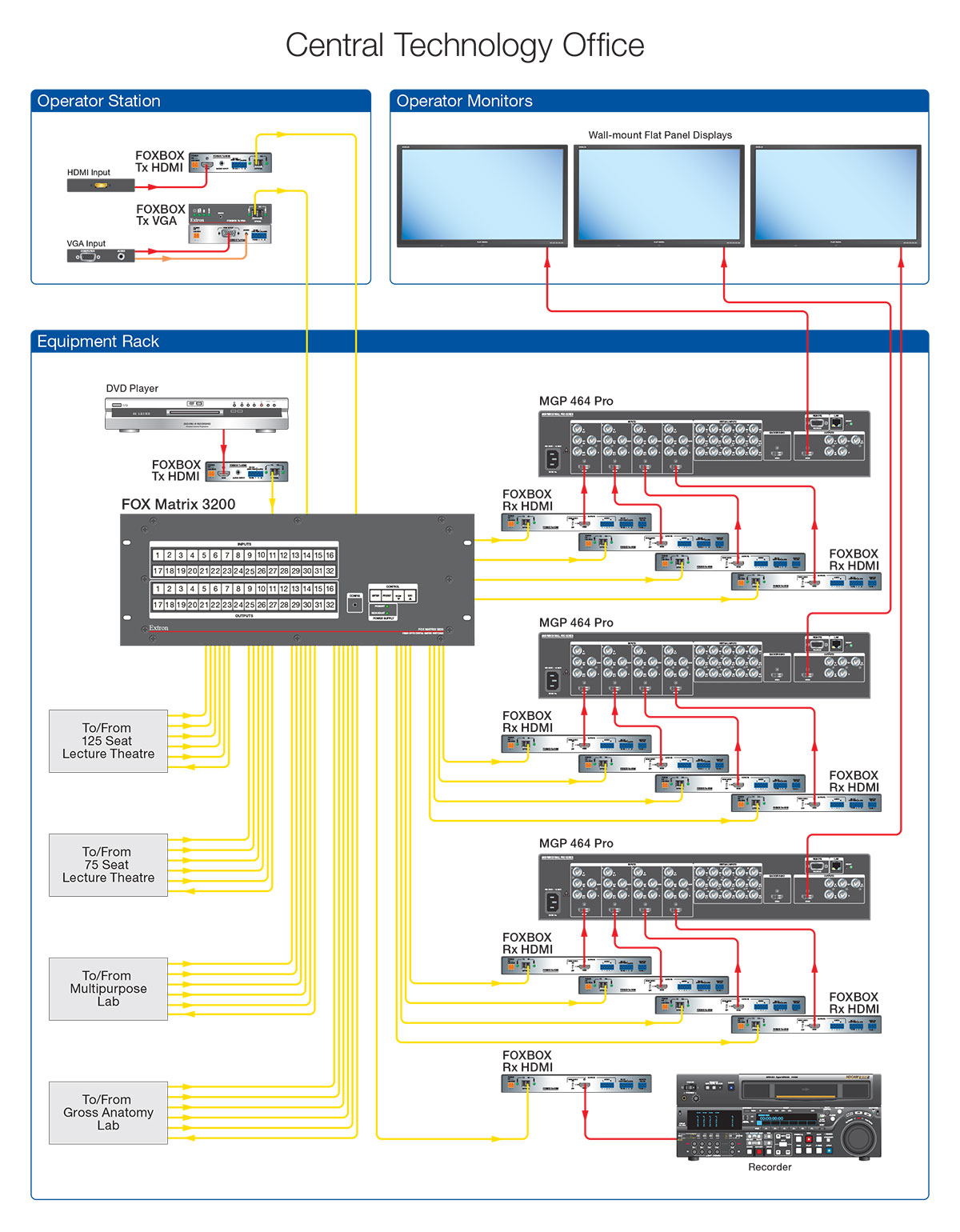
ROI of the Distributed Medical Training Program
The program’s return on investment has been and continues to be substantial. Currently, the MD program can accept 288 new students each year, more than doubling the number of annual enrollments since 2003/2004. Up to 192 applicants enroll in the Vancouver Fraser Medical Program at UBC annually, and the regional programs accept an additional 32 students per campus. Students attend the first two years of instruction at one of the four universities: UBC in Vancouver, UNBC in the north, UVic in Victoria, or the University of British Columbia Okanagan – UBCO in the southeast.
Clinical training in the third and fourth years includes rotations and rounds at hospitals and clinics followed by graduation and a residency period of two to seven years. Unlike traditional programs that involve facilities in a single geographical location, the distributed learning model enables students and residents participating from remote locations to gain experience in a wider variety of diseases and the latest treatment options. For example, residents, physicians, and other health professionals at 17 different facilities that included a number of rural practices recently attended an academic grand round held at Vancouver General. It was a hosted round as part of the postgraduate training program and continuing professional development. The distance education AV system ensured that each had an equal opportunity to participate.
An unanticipated benefit of the distributed training model is the added freedom it provides to faculty members. The distance education AV system allows instructors to relocate to communities beyond Vancouver. One of the first to take advantage of this new flexibility was the head of gross anatomy. After 30 years of teaching at UBC, he longed to live in Victoria but there were no FoM lab facilities on the island. With the completion of the DVP-enabled gross anatomy lab at UVic, he continues to run the gross anatomy department and teach from his new location in Victoria.
Information sharing goes beyond instructor-to-students; instructors with common specialties but at different facilities are now able to teach together using the distance education AV system. In one course, a specialist in Vancouver and another in Kelowna collaborate during sessions. They share the same field of specialization but with a different emphasis. Teaching from their respective locations, they cover two related topics each session to foster a better understanding of the subject matter. The AV system is the platform that permits this depth of instruction and level of communication.
The benefits associated with the Dual Visual Presence videoconferencing solution combined with the capabilities and future-proofing inherent with a fiber optic AV switching and distribution system are twofold. The distance education AV system enables students throughout the province to enroll in the prestigious FoM training program, which in turn encourages the new doctors to set up practices in the remote and underserved areas by offering medical instruction in the student’s home region. Just as vital, the sharing of information between fields of specialty and disciplines increases medical understanding and generates new treatments for the citizenry of British Columbia.
“The system has proven its value beyond that of undergraduate medical education. We’re seeing demand from a variety of health professionals wanting to extend their reach to all their colleagues in the province,” says Knezevic of UBC. “We’re proud because we’ve removed one of many barriers to retaining talented health professionals in our underserved areas.”
Global Acceptance and Adoption of the Distributed Training Model
The success of the distance education AV system has triggered other programs to adopt the distributed training model. The schools of Physical Therapy, Dentistry, and Pharmaceutical Sciences are making use of the DVP-enabled spaces or have developed their own distributed training programs.
Related programs are tied into the distance education AV system, with the FoM acting as the host from a videoconferencing perspective. Physical Therapy, which is a department of FoM, resides in a separate building at UBC linked through the distance education AV system. Because of the increasing number of applicants at UBC and UNBC, the Physical Therapy Department’s own distributed training program launched in late 2013.
As another health program, Dentistry partners with the FoM to share courses similar to both degrees for delivery from the Life Sciences Centre. DVP-enabled spaces allow this instruction sharing between the dental and MD programs.
The Faculty of Pharmaceutical Sciences is a separate faculty from the FoM. Program stakeholders adopted the distributed training model to increase the number of pharmacists in rural communities. The new DVP-enabled pharmaceutical sciences building at UBC went online in the autumn of 2012. The program’s distance education AV system enables the instructors to reach pharmacy students at the other universities and at the teaching hospitals. Similar to the distance education program designed for pharmaceutical sciences, the Business School at UBC is in the process of installing its own distance education AV system to be taken online in the near future.
Just as various faculties at UBC recognize the value of the distributed training model, the success in British Columbia continually draws the attention of public and private institutions. Many countries are experiencing the same issue of medical practices concentrated in and around the larger metropolitan areas, leaving the population in rural areas underserved. Delegations from universities around the world, including other Canadian provinces, the United States, Australia, and various European countries, have visited UBC to review the distance education AV system model.
Germany, as an example, has the same concerns about its underserved rural communities. Most doctors trained in Dusseldorf establish practices in the general vicinity. Beyond city limits there is a severe shortage of doctors. British Columbia’s distance education AV system proved to the German delegation that the best way to solve this problem is to educate the doctors where you want them to practice.
System in Review
According to Schoenenberger, three factors must be considered when converting an analog system to a digital solution. With 30% increase in heat load, the top concern is cooling and the HVAC system. The next concern is lighting. Digital cameras and other high resolution image-capturing devices require a substantial increase in lighting levels to produce a good quality signal. The third factor is the infrastructure, including networks and hardware for switching and distributing signals. Essentially, it is designing a system that is suitable for the current and next generations of technology. He modestly attributes much of the system’s success to the AV manufacturers he worked with on the UBC project.
“Extron and some other AV manufacturers are very much open to the input we provide, and it’s reflected in the features and functionalities that they design into their products,” Schoenenberger says. “This responsiveness plays a significant role in the decision-making process for us and our clients like UBC. It makes it very attractive to work with them.”
Impressions
Dr. Joanna Bates and Dr. David Snadden shared the vision of what a distributed medical training program could mean to the province. Dr. Bates spearheaded the project from its inception in 2002, and Dr. Snadden, Senior Executive Dean of Education for the UBC Faculty of Medicine and who is located at UNBC in Prince George, now champions the program. Both doctors worked closely with AV consulting firm McSquared to actualize their vision. McSquared evaluated available technologies, conducted extensive research, and performed a detailed cost/benefit analysis prior to selecting a fiber optic infrastructure. Through multi-year phases that include equipment upgrades and system expansion, the doctors, MedIT, and the consultant have achieved an award-winning program that serves as an example for education programs worldwide. The continued success of the program is attributable to the on-going commitment by all parties to the original vision.
Utilizing AV products from industry‑leading manufacturers, UBC and its partnering universities, regional teaching hospitals, remote practices, and the provincial health authorities have succeeded in creating a system that has a direct impact on society. The ratio of physicians to patients continues to improve and more practices are being established in the province’s rural areas every year. The unique distance education AV system has taken AV from an afterthought to the driving force that ensures an equal learning experience for the future doctors of British Columbia.


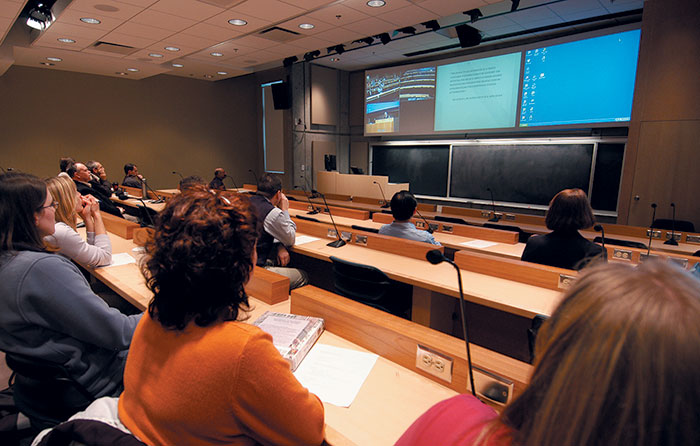
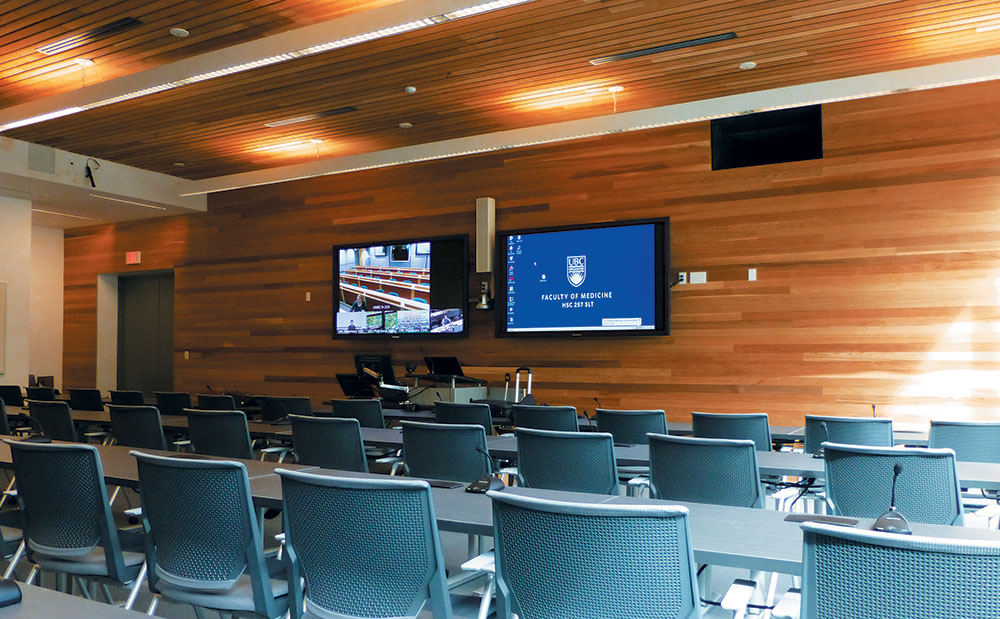
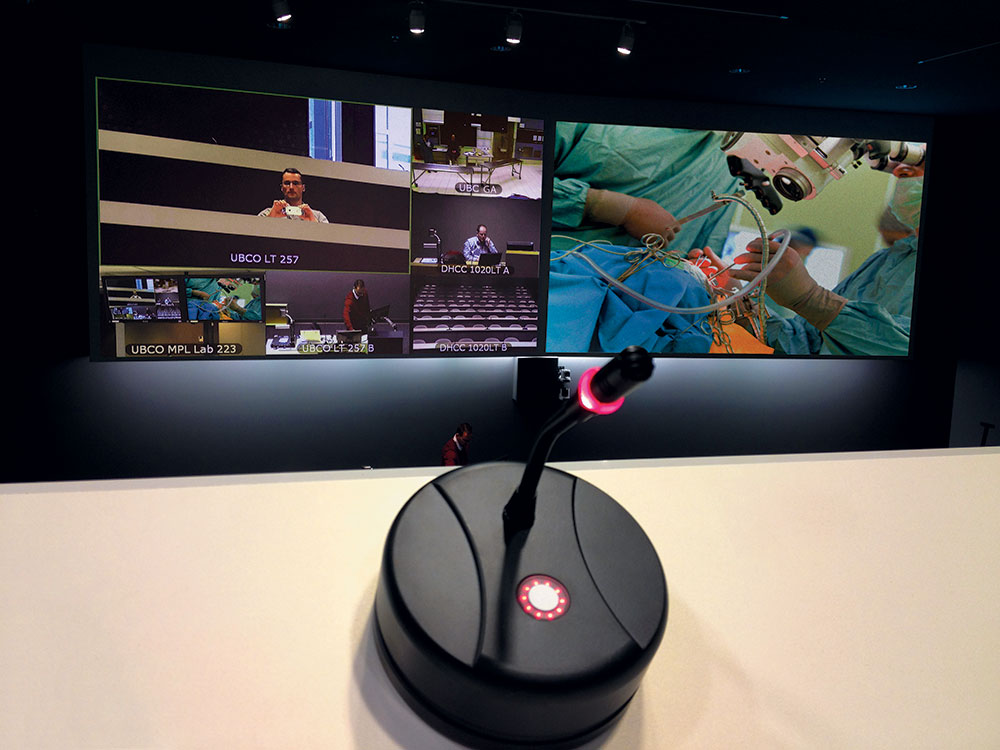
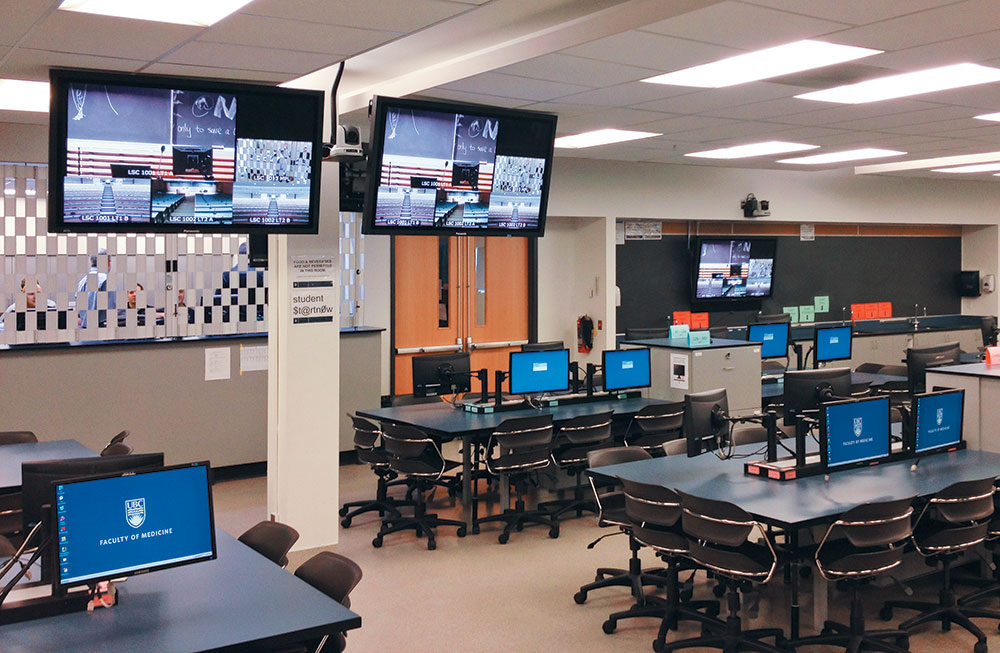
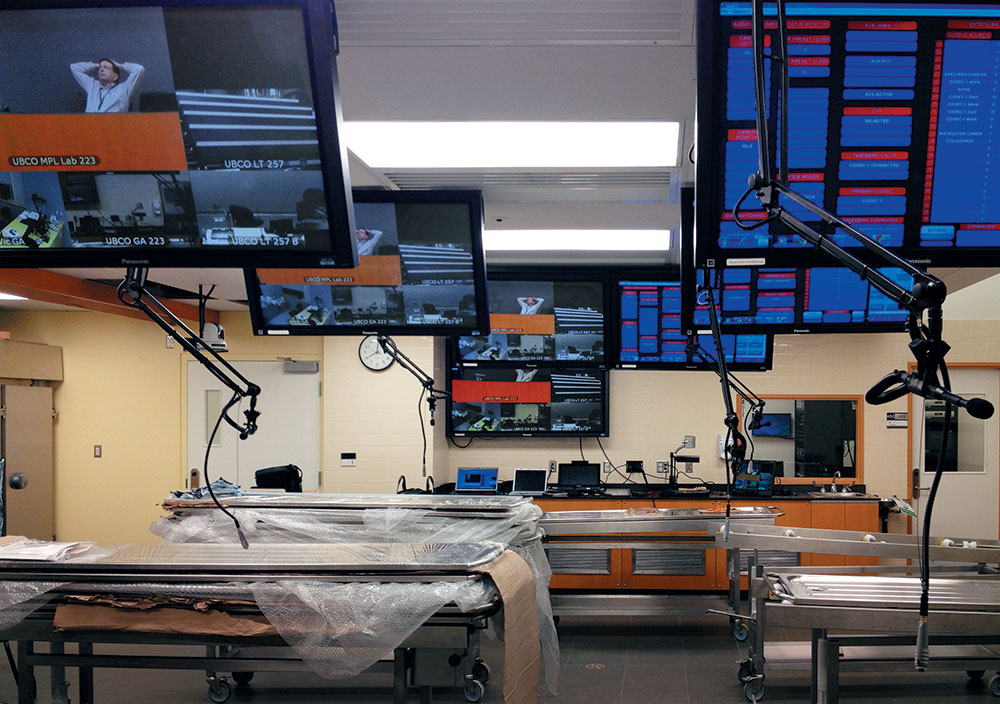
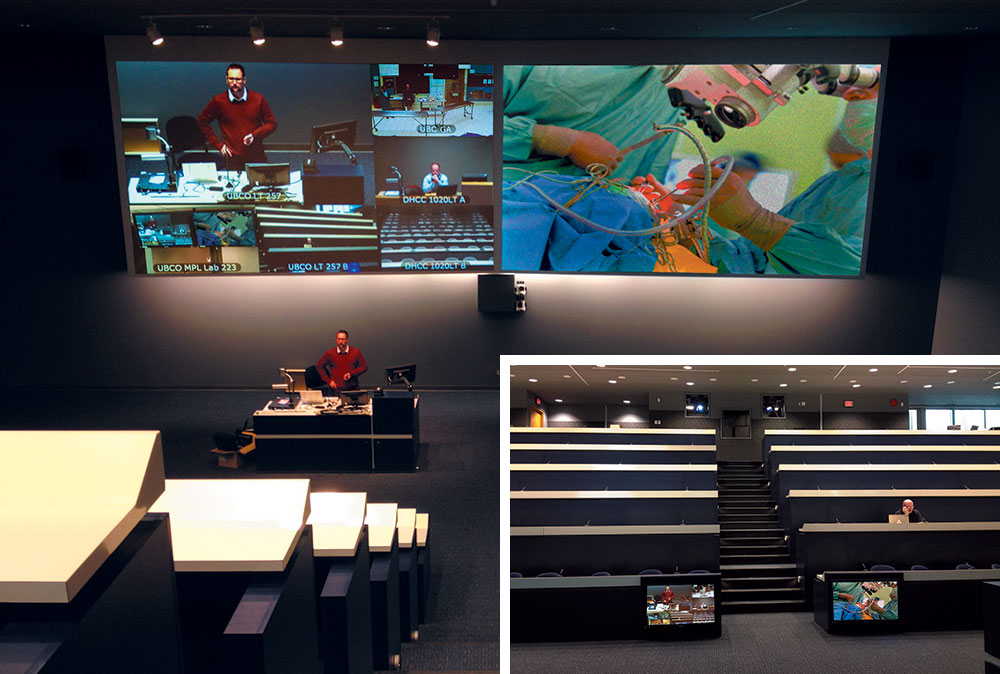
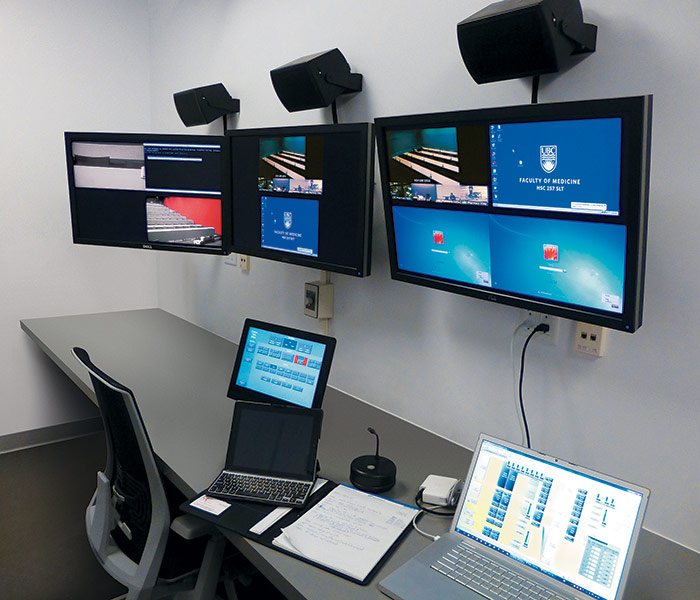
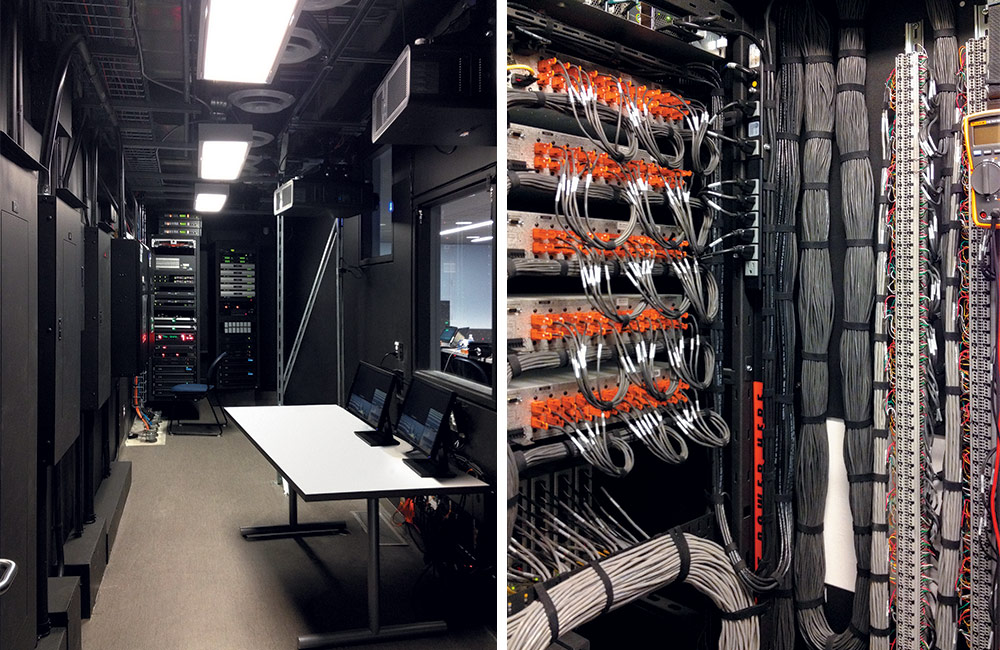

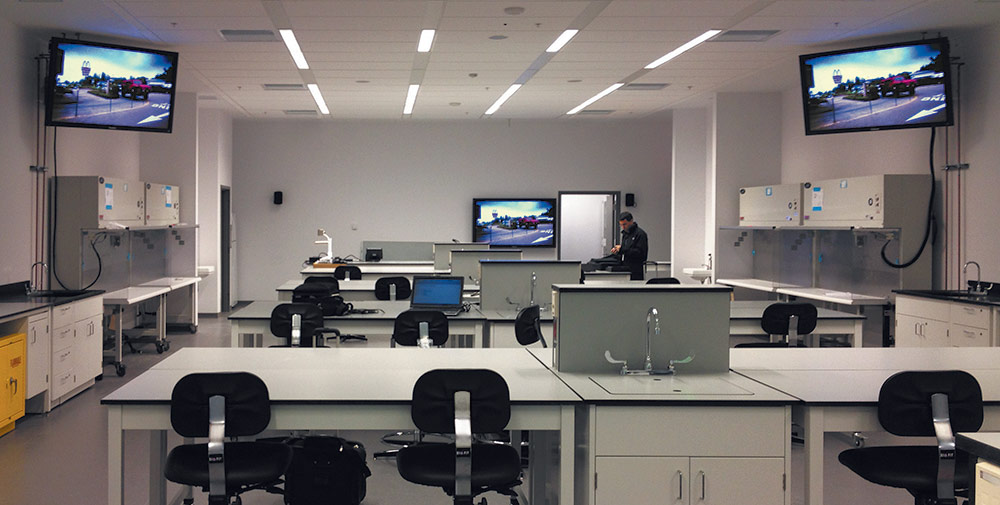
 Chrome
Chrome
 Firefox
Firefox
 Edge
Edge
 Safari
Safari